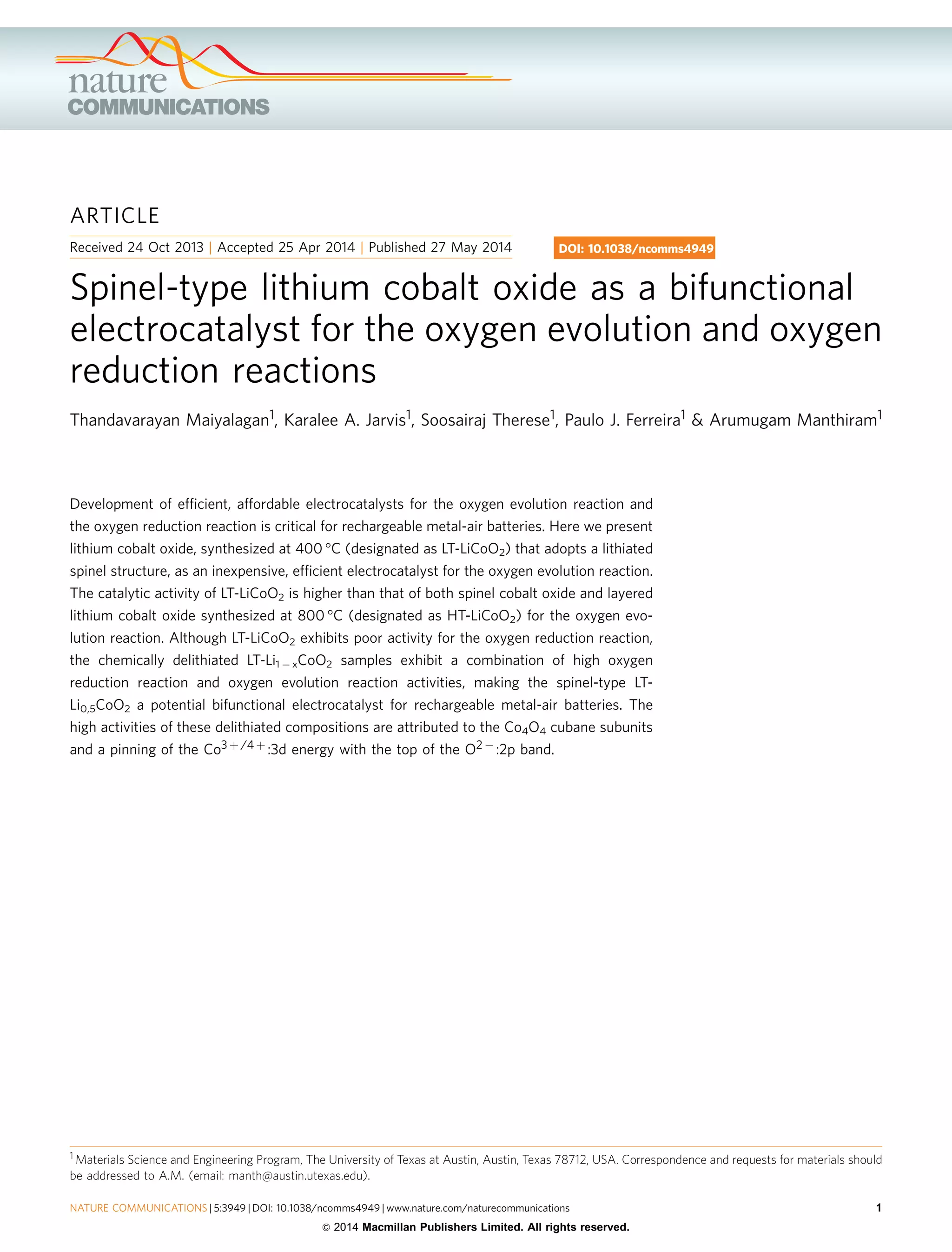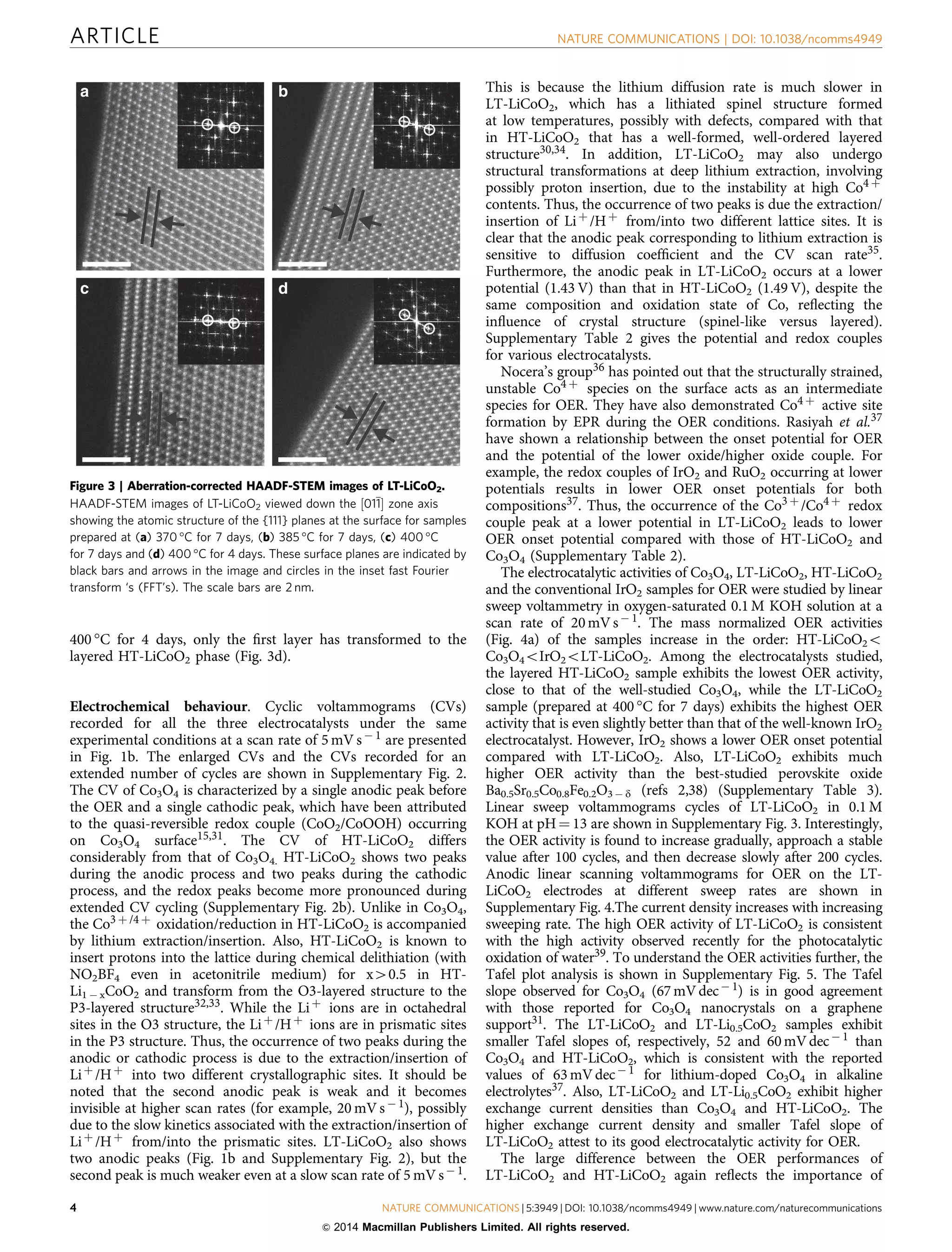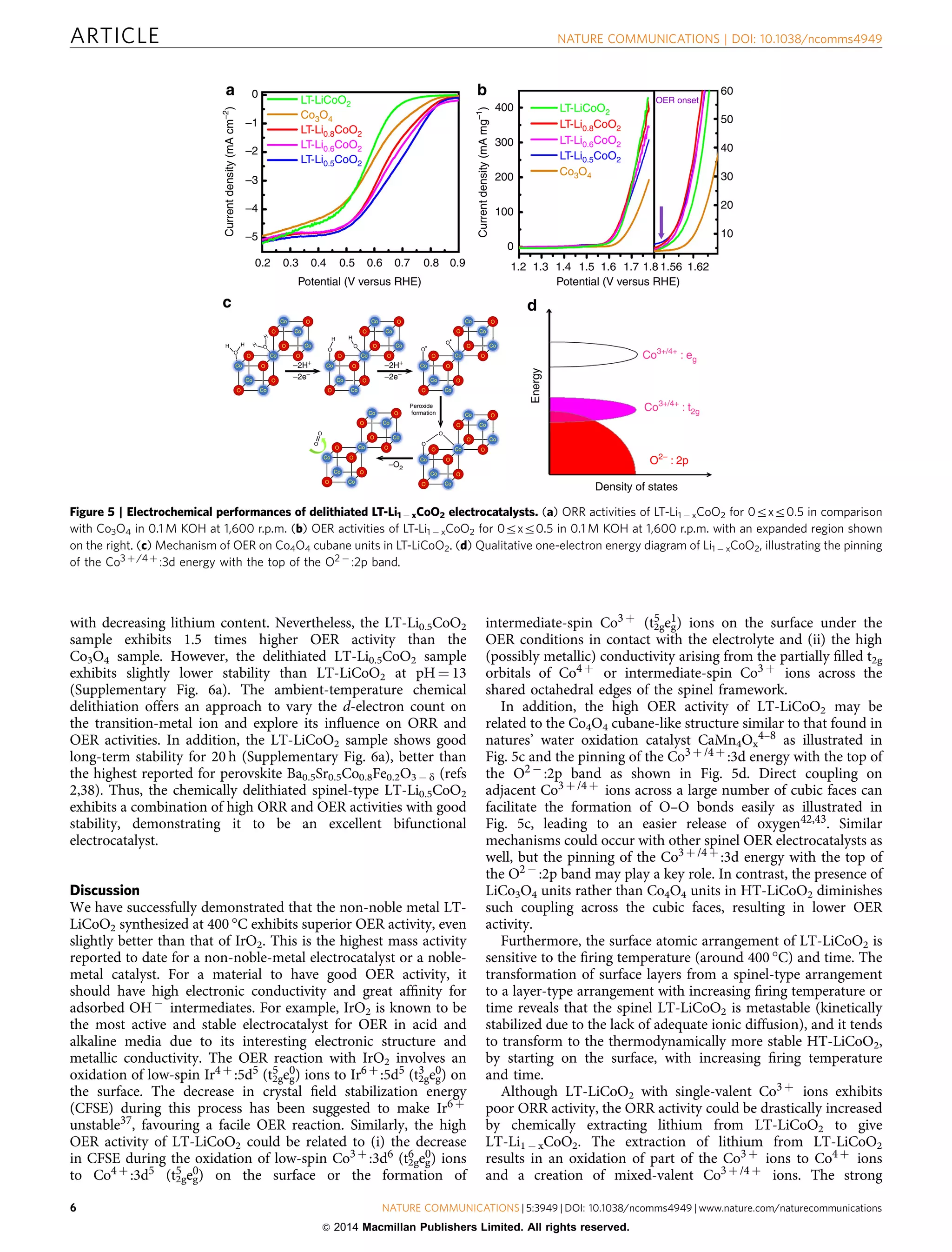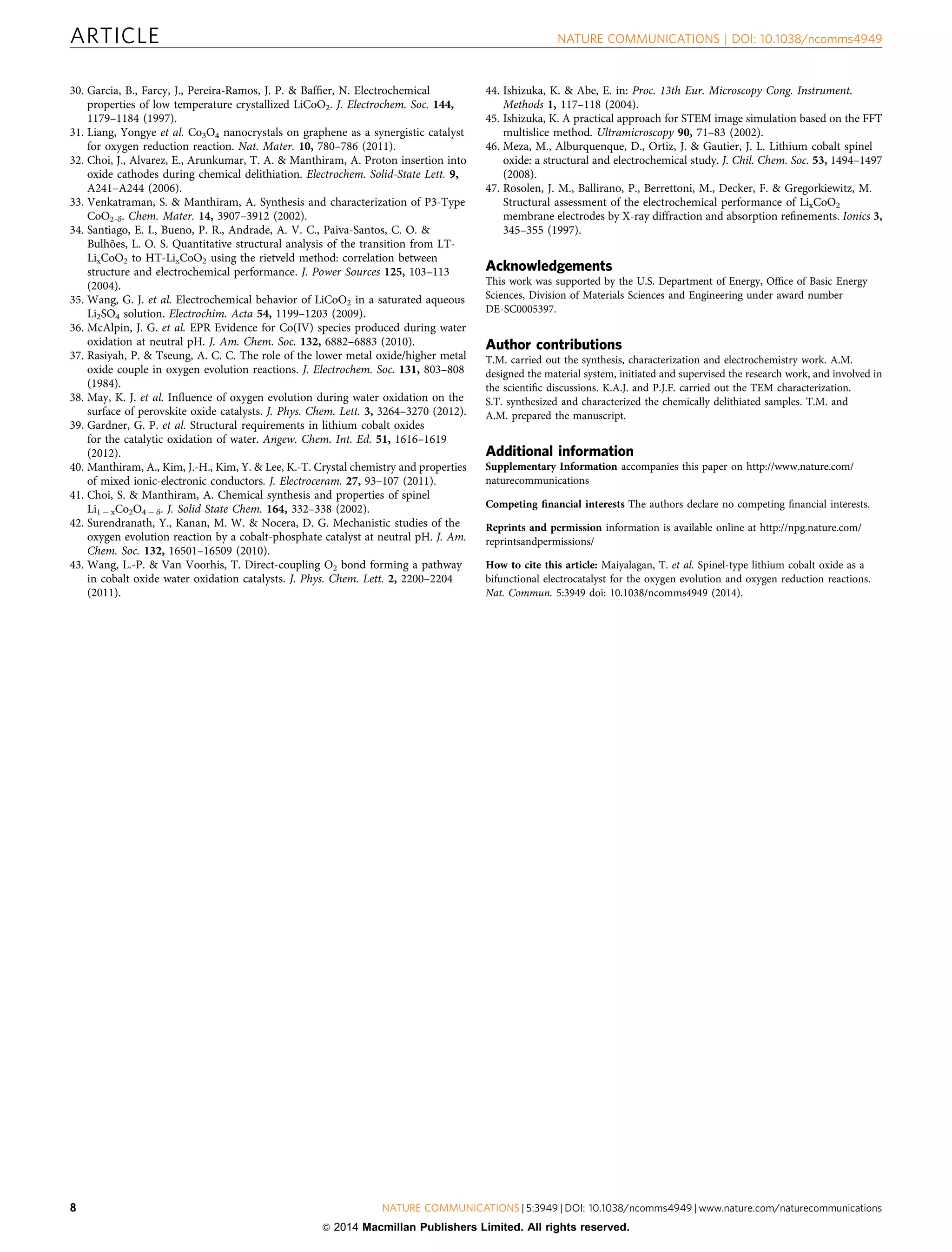The document discusses lithium cobalt oxide (LiCoO2) as a potential bifunctional electrocatalyst for the oxygen evolution reaction (OER) and oxygen reduction reaction (ORR). It finds that lithium cobalt oxide synthesized at a lower temperature of 400°C (LT-LiCoO2), which adopts a lithiated spinel structure, exhibits higher OER activity than layered LiCoO2 synthesized at 800°C (HT-LiCoO2) or spinel cobalt oxide. Chemically delithiated LT-LiCoO2 samples show both high OER and ORR activities, making spinel-type LT-Li0.5CoO2 a potential bifunctional electro

![O
xygen electrochemistry plays a major role in energy
conversion and storage devices, particularly in the field of
fuel cells, metal-air batteries and water electrolysers1–3.
The major challenge in metal-air batteries and water electrolysis
is to design and develop economically feasible, earth-abundant,
inexpensive, efficient electrocatalysts for the oxygen evolution
reaction (OER)4. In nature, water electrolysis is performed by the
photosystem II water-oxidizing complex containing CaMn4Ox
clusters that are capable of promoting water oxidation with
significant turnover frequencies at low overpotentials4–8.
However, it is difficult to use these naturally occurring enzymes
in commercial electrochemical devices due to their instability
under the operating conditions9. Precious-metal electrocatalysts
such as Pt, IrO2 and RuO2 are normally employed, but their low
abundance and high cost prohibit their practical use10. Pt exhibits
inadequate OER activity due to the formation of the insulating
platinum oxides. RuO2 becomes unstable at high potentials due to
the formation of higher-valent ruthenium oxides. IrO2 is the best
electrocatalyst so far for OER. Moreover, it is difficult to get both
acceptable OER and oxygen reduction reaction (ORR) activities
with the same material. Therefore, a burgeoning effort by
chemists is to develop inexpensive materials with high
electrocatalytic activity and stability for OER or preferably for
both OER and ORR, but it remains a daunting scientific
challenge. In addition, electrolysis of water is generally
preferred in alkaline medium over acidic medium because of
the less expensive materials for construction and less
susceptibility to corrosion11–13.
Transition metal oxides containing highly oxidized redox
couples such as Ir4 þ /6 þ , Ru4 þ /8 þ , Co3 þ /4 þ , Ni3 þ /4 þ ,
Mn3 þ /4 þ and Fe3 þ /4 þ are known as active centres for OER.
The electrochemical performance of oxides for OER follows
the order, IrO24RuO24Co3O4 and Ni-containing cobalt
oxides4Fe, Pb, Mn containing oxides. Among the numerous
low-cost oxides investigated, cobalt oxides are promising for both
OER and ORR14–18 and have been largely studied as stable
electrocatalysts for OER in highly alkaline solutions19. For
example, spinel NiCo2O4 and Co3O4 have been found by
several groups to show good efficiency and long-term
performance, but they underperform relative to IrO2 (ref. 20).
Co3O4 nanoparticles have also been anchored onto suitable
conducting supports to prevent the agglomeration of
nanoparticles and thereby increase the electrocatalytic activity.
Recently, Liang et al.21 have used Co3O4 nanocrystals anchored
onto graphene, while Frei and co-workers22 have developed
efficient water oxidation electrocatalysts by supporting MnOx and
Co3O4 clusters on mesoporous silica scaffolds. Also, Kanan
et al.23 have used cobalt phosphate as an electrocatalyst for water
oxidation.
With an aim to develop highly active electrocatalysts based on
earth-abundant elements for both OER and ORR, we focus here
on LiCoO2 as an electrocatalyst. LiCoO2 has been intensively
studied as a cathode material for lithium-ion batteries24. LiCoO2
is known to exist in two forms as described below. The LiCoO2
sample synthesized at high temperatures (B800 °C) has the
a-NaFeO2 structure (space group: R3m) in which the Liþ and
Co3 þ ions order on alternate {111} planes of the rock salt
structure due to the large size and charge differences between the
Liþ and Co3 þ ions25. We designate this high-temperature form
as HT-LiCoO2. In contrast, the LiCoO2 sample synthesized at
lower temperatures (B 400 °C) adopts a lithiated spinel structure
{Li2}16c[Co2]16dO4 in which the Co3 þ ions occupy all the 16d
octahedral sites, while the Liþ ions occupy all the 16c octahedral
sites of the spinel framework (space group: Fd3m)26. We
designate this low-temperature form as LT-LiCoO2. In this
paper, we compare the activities of LT-LiCoO2 and HT-LiCoO2
having the same composition but different structures for OER in
alkaline medium. LT-LiCoO2 and HT-LiCoO2, both consisting of
Co3 þ ions, offer a unique platform to explore the structure-
activity relationship for OER. While LT-LiCoO2 consists of the
cubane-like cubic Co4O4 units, HT-LiCoO2 consists of LiCo3O4
units. Also, the changes in the surface structure of LT-LiCoO2
and its OER activity as a function of the firing time and
temperature around 400 °C are presented. We also compare the
OER and ORR activities of chemically delithiated LT-Li1 À xCoO2
as a function of lithium content (0rxr0.5) and the oxidation
state of Co with an aim to utilize it as a bifunctional
electrocatalyst for OER and ORR.
Results
Bulk and surface structures. Both the atomic and electronic
structures, particularly on the surface under the electrochemical
operating conditions, play a critical role in imparting the elec-
trocatalytic activity for OER and ORR. Figure 1a shows the X-ray
diffraction patterns of LT-LiCoO2, HT-LiCoO2 and Co3O4. While
the LT-LiCoO2 synthesized at 400 °C shows a single reflection
around 2yE63° corresponding to the {440} plane of the cubic
lithiated spinel (Fd3m), it splits into the (108) and (110) reflec-
tions of the layered HT-LiCoO2 structure (R3m) on heating to
800 °C27–30. Also, the (220) reflection present in Co3O4 is absent
in LT-LiCoO2 due to the absence of ions with high scattering
68 1.2
0.0
(110)
1.61.41.2
1.61.41.2
(108)
(113)
(110)
(108)
(107)
(015)
(104)
(006)(012)
(101)
(003)(111)
(311)
(222)
(400)
(311)
(511)
(440)
(531)
(440)
(440)
(440)
(511)
(422)
(400)
(222)
(311)
(220)
(111)
Co3O4
LT-LiCoO2
HT-LiCoO2
HT-LiCoO2
LT-LiCoO2
Co3O4
Co3+
Co3+
Co3+
Co4+
Co4+
Co4+
0.4
0
2
4
0
1
2
1.3 1.4 1.5 1.6676665646040
2 Theta (degrees) Potential (V versus RHE)
Currentdensity(mAcm–2
)
Intensity(a.u.)
20
a b
Figure 1 | X-ray diffraction patterns and electrochemical behaviour of electrocatalysts. (a) X-ray diffraction patterns of Co3O4, LT-LiCoO2 and
HT-LiCoO2, illustrating the splitting of the (440) reflection in the cubic spinel LT-LiCoO2 into (108) and (110) reflections in the rhombohedral-layered
LT-LiCoO2 as shown in the expanded region of 2y ¼ 64–68°. (b) Cyclic voltammograms of Co3O4, LT-LiCoO2 and HT-LiCoO2 in 0.1 M KOH at scan
rate of 5 mVsÀ 1. The purple, blue and green colours in the structures shown in the insets of b refer, respectively, to the polyhedra of Co3 þ , Co2 þ and
Liþ ions.
ARTICLE NATURE COMMUNICATIONS | DOI: 10.1038/ncomms4949
2 NATURE COMMUNICATIONS | 5:3949 | DOI: 10.1038/ncomms4949 | www.nature.com/naturecommunications
2014 Macmillan Publishers Limited. All rights reserved.](https://image.slidesharecdn.com/spinel-typelithiumcobaltoxideasabifunctionalelectrocatalystforoxygenreductionandoxygenevolutionreact-150719044447-lva1-app6891/75/Spinel-type-lithium-cobalt-oxide-as-a-bifunctional-electrocatalyst-for-oxygen-reduction-and-oxygen-evolution-reactions-nature-communications-2-2048.jpg)
![power in the 8a tetrahedral sites of the spinel lattice in LT-
LiCoO2. Co3O4 has the cubic spinel structure with a cation
distribution of (Co2 þ )8a[Co2
3 þ ]16dO4 in which all the Co3 þ ions
occupy the 16d octahedral sites, while all Co2 þ ions occupy the
8a tetrahedral sites. Supplementary Fig. 1 shows the Rietveld
refinement of the X-ray diffraction data of LT-LiCoO2 and HT-
LiCoO2 along with Co3O4. The observed and calculated patterns
match well with each other, validating the cubic lithiated spinel
structure of LT-LiCoO2. The structural parameters obtained from
the Rietveld refinement are given in Supplementary Table 1.
Figure 2 shows the aberration-corrected high angular annular
dark-field scanning transmission electron microscopy (STEM)
images of the three samples, viewed down the 011½ Š zone axis. The
atomic arrangement in the Co3O4 particle matches that expected
for the spinel lattice with the space group Fd3m, where the Co3 þ
ions occupy the octahedral sites and Co2 þ ions occupy the
tetrahedral sites (Fig. 2c,d). The particle maintains this structure
all the way to the surface on both the {001} and {111} planes
(Fig. 2a,b, respectively). As a comparison, the surfaces of the {001}
and the {111} planes in HT-LiCoO2 are shown in Fig. 2e,f. The
overall structure matches that of a trigonal lattice with the space
group R3m (Fig. 2g,h). For ease of comparison, we will use the
cubic system, which is the most basic structure of HT-LiCoO2, for
the notation of the planes in both the figures and the discussion of
HT-LiCoO2. The bulk structure of HT-LiCoO2 is maintained all
the way to the surface on the {111} planes (Fig. 2f), but shows
some variation for a few layer of the {001} surface (Fig. 2e). At
this surface, there are some bright atomic columns of Co that
appear in the Li layers, suggesting that some Co might have
moved into the lithium layer at the {001} cubic surface. The bulk
structure of LT-LiCoO2 is shown in Fig. 2i, and it indicates that
the structure corresponds to a spinel lattice with the space group
Fd3m and Co and Li occupying, respectively, all the 16d and 16c
octahedral sites (Fig. 2j,k). The structure of the {001} planes is
maintained all the way to the surface (Fig. 2i). The structure of
the {111} planes at the surface, however, is modified under certain
synthesis conditions (Fig. 3). For example, for a firing
temperature of 370 °C for 7 days, the spinel structure is
maintained all the way to the {111} surface (Fig. 3a). For firing
temperatures of 385 and 400 °C for 7 days, however, a few atomic
layers of the {111} surface planes have transformed to the layered
HT-LiCoO2 (Fig. 3b,c). In contrast, for a firing temperature of
a b c
e f g
i j
d
[111]
h
k
[111]
[111]
[112]
[112]
[112]
Figure 2 | Aberration-corrected HAADF-STEM images of electrocatalyts. HAADF-STEM images of (a–d) Co3O4, (e–h) HT-LiCoO2 and (i–k) LT-LiCoO2
viewed down the 011½ Š zone axis, showing the surface structure at the (a,e,i) {001} plane and (b,f) {111} plane. These surface planes are indicated
by black bars and arrows in the image and circles in the inset fast Fourier transform’s (FFT’s). The unit cells for each composition with octahedral and
tetrahedral arrangements are overlaid on higher magnification images that have been deconvoluted to reduce noise in (c,g,j)44. The blue, purple and
green atoms refer, respectively, to Co 2 þ , Co3 þ and Liþ . The simulated STEM images are shown in (d,h,k). To facilitate a comparison of the three
materials, the deconvoluted and simulated images have been rotated relative to the STEM images, so that all the {111} planes lie on the horizontal axis.
Scale bar, 2 nm.
NATURE COMMUNICATIONS | DOI: 10.1038/ncomms4949 ARTICLE
NATURE COMMUNICATIONS | 5:3949 | DOI: 10.1038/ncomms4949 | www.nature.com/naturecommunications 3
2014 Macmillan Publishers Limited. All rights reserved.](https://image.slidesharecdn.com/spinel-typelithiumcobaltoxideasabifunctionalelectrocatalystforoxygenreductionandoxygenevolutionreact-150719044447-lva1-app6891/75/Spinel-type-lithium-cobalt-oxide-as-a-bifunctional-electrocatalyst-for-oxygen-reduction-and-oxygen-evolution-reactions-nature-communications-3-2048.jpg)



![covalency arising from a pinning of the Co3 þ /4 þ :3d states with
the top of the O2 À :2p band as shown in Fig. 5d along with the
high electronic conductivity arising from the partially filled
Co3 þ /4 þ :t2g band across the shared edges of the 3-dimensional
spinel framework lead to high ORR activity on extracting lithium
from LT-LiCoO2. Thus, the partially delithiated LT-Li0.5CoO2,
which could actually be a normal, ideal spinel (Li)8a[Co2]16dO4,
with mixed-valent Co3 þ /4 þ , offers a combination of high ORR
and OER activities. Overall, the spinel-type delithiated LT-
Li0.5CoO2 behaves as a bifunctional electrocatalyst for OER and
ORR in electrochemical devices such as rechargeable lithium-air
batteries. Moreover, the chemical delithiation approach presented
here to vary the number of d electrons on the transition-metal ion
without changing the structure could be explored systematically
with other compositions in the future (i) to correlate the
d-electron count to ORR and OER activities and (ii) to develop
a better understanding of the catalytic mechanisms of ORR
and OER.
Methods
Synthesis and characterization. IrO2 was purchased from Alfa Aesar. The
lithiated spinel LT-LiCoO2 samples were synthesized by a solid-state reaction of
stoichiometric amounts of Li2CO3 and Co3O4 at 370–400 °C for various durations
(4–7 days), followed by slow furnace cooling. The layered HT-LiCoO2 sample was
synthesized by solid-state reaction of stoichiometric amounts of Li2CO3 and Co3O4
at 800 °C for 24 h, followed by slow furnace cooling. The samples were char-
acterized by X-ray diffraction with Cu Ka radiation. A Rietveld refinement of the
X-ray diffraction data was carried out with the FullProf program. Multi-point
Brunauer–Emmett–Teller (BET) surface areas of the samples were collected with
an automatic nitrogen gas sorption analyser (NOVA 2000, Quantachrome) using
physical adsorption at 77 K.
Chemical extraction of lithium from LT-LiCoO2 was carried out with a Schlenk
line under argon atmosphere at room temperature with the oxidizer NO2BF4 in
acetonitrile medium41:
LT-LiCoO2 þ xNO2BF4-LT-Li1 À xCoO2 þ xLiBF4 þ xNO2(1)
The amount of lithium extracted was controlled by altering the amount of
NO2BF4 in the reaction medium. Typically, 200 mg of LT-LiCoO2 was reacted
with a specific amount of NO2BF4 in 20 ml of anhydrous acetonitrile. After reacting
for 1 day, the product formed was washed several times with acetonitrile to
remove the byproduct LiBF4 and then dried in an air oven at 100 °C. The lithium
content in the delithiated sample was analysed by inductively coupled plasma (ICP)
analysis.
For STEM analysis, the powders were suspended in isopropanol, sonicated and
placed onto a lacey carbon grid. The samples thus prepared were imaged on a JEOL
ARM200F TEM/STEM equipped with a CEOS corrector (CEOS GmbH,
Heidelberg, Ger.) for the illuminating lenses and a high-angle annular dark-field
detector. Some of the high-resolution STEM images were deconvoluted using the
maximum entropy method implemented by Ishizuka and Abe44. To simulate the
STEM images, atomic models were created in Diamond 3.2i and exported to the
high-resolution electron microscopy simulation suite, which is a TEM/STEM
simulation software package based on the fast Fourier transform multislice
technique45. For all the compositions, the multislice simulations were carried out
assuming a step scanning size of 0.2 Å (less than the distance to be resolved) and a
minimum slice thickness of 1.0 Å. The Debye-Waller factor (B), which is related to
the mean square of the thermal displacement of an atom from its equilibrium
position, was taken from the literature. In particular, the structures and B values for
each atomic position were taken from the following: the crystal structure and
temperature factors were taken from Meza et al.46 for Co3O4, from our X-ray
diffraction data with temperature factors all set to one for LT-LiCoO2, and from
Rosolen et al.47 for HT-LiCoO2.
Electrochemical measurements. Typically, 16 mg of the electrocatalyst sample
and 3.2 mg of carbon black were dispersed in 8 ml of ethanol/water (1:1 ratio) and
73.2 ml of 5% Nafion solution by ultrasonication for 30 min to form a homogeneous
catalyst ink. The catalyst ink was then coated onto the RDE (0.196 cm2) at a
loading of 0.25 mgoxide cmÀ 2
disk and dried at room temperature. Before the coating
of the catalyst, the glassy carbon electrode (5 mm diameter) was polished with
Al2O3 paste (0.05 mm) and washed ultrasonically with double-distilled water. All
the electrochemical measurements were performed with a saturated calomel elec-
trode as the reference electrode and a platinum foil counter electrode at a scan rate
of 20 mV sÀ 1 in 0.1 M KOH by purging a slow stream of purified oxygen gas
towards the working electrode. The rotation speed of RDE was 1,600 r.p.m. for all
measurements. Infrared (current  internal resistance) compensation was applied
to linear sweep voltammetry experiments using the Nova software supplied with
the Autolab cyclic voltammetry instrument. All potentials reported in this paper
are relative to the reversible hydrogen electrode. The mass activity was normalized
to the loading of the oxide catalyst.
References
1. Mallouk, T. E. Water electrolysis: Divide and conquer. Nat. Chem. 5, 362–363
(2013).
2. Suntivich, J., May, K. J., Gasteiger, H. A., Goodenough, J. B. Shao-Horn, Y.
A perovskite oxide optimized for oxygen evolution catalysis from molecular
orbital principles. Science 334, 1383–1385 (2011).
3. Turner, J. A. Sustainable hydrogen production. Science 305, 972–974 (2004).
4. Kanan, M. W. Nocera, D. G. In situ formation of an oxygen-evolving catalyst
in neutral water containing phosphate and Co2 þ . Science 321, 1072–1075
(2008).
5. Ferreira, K. N., Iverson, T. M., Maghlaoui, K., Barber, J. Iwata, S. Architecture
of the photosynthetic oxygen-evolving center. Science 303, 1831–1838 (2004).
6. Dismukes, G. C. et al. Development of bioinspired Mn4O4—cubane water
oxidation catalysts: lessons from photosynthesis. Acc. Chem. Res. 42,
1935–1943 (2009).
7. Manchanda, R., Brudvig, G. W. Crabtree, R. H. High-valent oxomanganese
clusters: structural and mechanistic work relevant to the oxygen-evolving
center in photosystem II. Coord. Chem. Rev. 144, 1–38 (1995).
8. Brimblecombe, R., Bond, A. M., Dismukes, G. C., Swiegers, G. F. Spiccia, L.
Electrochemical investigation of Mn4O4-cubane water-oxidizing clusters. Phys.
Chem. Chem. Phys. 11, 6441–6449 (2009).
9. Trasatti, S. Electrocatalysis by oxides—attempt at a unifying approach.
J. Electroanal.Chem. 111, 125–131 (1980).
10. Gordon, R. B., Bertram, M. Graedel, T. E. Metal stocks and sustainability.
Proc. Natl Acad. Sci. 103, 1209–1214 (2006).
11. Divisek, J., Malinowski, P., Mergel, J. Schmitz, H. Improved components for
advanced alkaline water electrolysis. Int. J. Hydrogen Energy 13, 141–150
(1988).
12. Yin, Q. et al. A fast soluble carbon-free molecular water oxidation catalyst
based on abundant metals. Science 328, 342–345 (2010).
13. Risch, M. et al. Cobalt—oxo core of a water-oxidizing catalyst film. J. Am.
Chem. Soc. 131, 6936–6937 (2009).
14. Jiao, F. Frei, H. Nanostructured cobalt and manganese oxide clusters as
efficient water oxidation catalysts. Energy Environ. Sci. 3, 1018–1027 (2010).
15. Chou, N. H., Ross, P. N., Bell, A. T. Tilley, T. D. Comparison of cobalt-based
nanoparticles as electrocatalysts for water oxidation. Chem. Sus. Chem. 4,
1566–1569 (2011).
16. McAlpin, J. G., Stich, T. A., Casey, W. H. Britt, R. D. Comparison of cobalt
and manganese in the chemistry of water oxidation. Coord. Chem. Rev. 256,
2445–2452 (2012).
17. Bashyam, R. Zelenay, P. A class of non-precious metal composite catalysts
for fuel cells. Nature 443, 63–66 (2006).
18. Petitto, S. C., Marsh, E. M., Carson, G. A. Langell, M. A. Cobalt oxide surface
chemistry: The interaction of CoO (100), Co3O4 (110) and Co3O4 (111) with
oxygen and water. J. Mol. Catal. A 281, 49–58 (2008).
19. Miles, M. H. Evaluation of electrocatalysts for water electrolysis in alkaline
solutions. J. Electroanal. Chem. 60, 89–96 (1975).
20. Singh, R. N., Koenig, J. F., Poillerat, G. Chartier, P. Electrochemical studies
on protective thin Co3O4 and NiCo2O4 films prepared on titanium by spray
pyrolysis for oxygen evolution. J. Electrochem. Soc. 137, 1408–1413 (1990).
21. Koza, J. A., He, Z., Miller, A. S. Switzer, J. A. Electrodeposition of crystalline
Co3O4—a catalyst for the oxygen evolution reaction. Chem. Mater. 24,
3567–3573 (2012).
22. Jiao, F. Frei, H. Nanostructured manganese oxide clusters supported on
mesoporous silica as efficient oxygen-evolving catalysts. Chem. Commun. 46,
2920–2922 (2010).
23. Kanan, M. W., Surendranath, Y. Nocera, D. G. Cobalt-phosphate oxygen-
evolving compound. Chem. Soc. Rev. 38, 109–114 (2009).
24. Goodenough, J. B. Kim, Y. Challenges for rechargeable Li batteries. Chem.
Mater. 22, 587–603 (2009).
25. Gummow, R. J., Liles, D. C. Thackeray, M. M. Spinel versus layered
structures for lithium cobalt oxide synthesised at 400°C. Mater. Res. Bull. 28,
235–246 (1993).
26. Gummow, R. J., Thackeray, M. M., David, W. I. F. Hull, S. Structure and
electrochemistry of lithium cobalt oxide synthesised at 400°C. Mater. Res. Bull.
27, 327–337 (1992).
27. Gummow, R. J. Thackeray, M. M. Lithium-cobalt-nickel-oxide cathode
materials prepared at 400°C for rechargeable lithium batteries. Solid State Ionics
53–56, 681–687 (1992).
28. Rossen, E., Reimers, J. N. Dahn, J. R. Synthesis and electrochemistry of spinel
LT-LiCoO2. Solid State Ionics 62, 53–60 (1993).
29. Garcia, B. et al. The structure of low temperature crystallized LiCoO2. Solid
State Ionics 80, 111–118 (1995).
NATURE COMMUNICATIONS | DOI: 10.1038/ncomms4949 ARTICLE
NATURE COMMUNICATIONS | 5:3949 | DOI: 10.1038/ncomms4949 | www.nature.com/naturecommunications 7
2014 Macmillan Publishers Limited. All rights reserved.](https://image.slidesharecdn.com/spinel-typelithiumcobaltoxideasabifunctionalelectrocatalystforoxygenreductionandoxygenevolutionreact-150719044447-lva1-app6891/75/Spinel-type-lithium-cobalt-oxide-as-a-bifunctional-electrocatalyst-for-oxygen-reduction-and-oxygen-evolution-reactions-nature-communications-7-2048.jpg)
